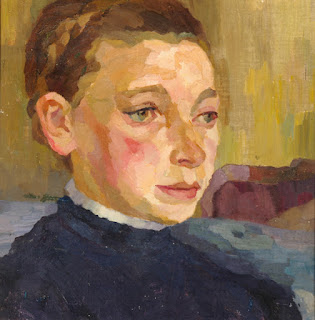Wednesday, May 29, 2024
Professor MAX FELDBAUER (1869-1948): “Der Engel & der Bauer” ….. The Angel and the Farmer -1910
----------------The Artist: Max Felbauer (1869-1948)
This painting (Below) is on it's way to the US. Fingers crossed that it makes it into my collection and doesn't vaporize. There are a number of stories and poems out there regarding the theme of this painting. There is a famous painting in the Vatacan on the same theme. My favorite interpretation of the event is this one: "The story of 'The Old Farmer and the Angel' illustrates the theme of contentment and joyfulness. The old farmer, despite his age and presumably modest life, is content and happy. When presented with the opportunity to make a wish by the angel, he doesn't ask for material wealth or anything extravagant. Instead, he expresses his happiness with the current moment and the very presence of the angel. The story conveys the idea that true happiness can be found in simple things, appreciating what one has, and in cherishing the present moment rather than constantly seeking more. It's a reminder that joyfulness amd contentment come from within and aren't always dependent on external circumstances or possessions.----------- Here is a brief biography of the artist: ------"Max Feldbauer (1869–1948) was a German painter, associated with the Munich Secession. He is primarily known for rural, Bavarian scenes. His father, Josef Feldbauer, served as the mayor of Neumarkt from 1868 to 1876. After his father and his five younger siblings had died, he and his mother moved to Munich. His first art lessons were at the Kunstgewerbeschule. He then attended the private art school operated by Simon Hollósy, where he was introduced to Impressionism, and continued his studies at the Academy of Fine Arts, Munich. His instructors there included Otto Seitz, Paul Hoecker and Johann Caspar Herterich.
In 1899, he married the painter, Elise Eigner, of Schwandorf. From 1901 to 1915, he taught at the Academy of the Münchner Künstlerinnenverein [de] (women artists' association). In 1908, he joined the Munich Secession. He also ran his own painting school, in Mitterndorf, near the Dachau art colony, from 1912 to 1922. He left the Secession in 1913; becoming one of the founders of the New Secession [de], and served as a board member. In addition to all of these activities, he provided illustrations for Die Jugend (Youth), a weekly arts magazine.
After several trips through France and Italy, he settled near Dachau. In 1916, he was appointed to teach at the Kunstgewerbeschule Dresden [de] (arts and crafts school) then, in 1918, to the Dresden Academy of Fine Arts, where he served as President in 1928. After the Nazis came to power in 1933, he was initially banned from exhibiting.
He returned to Munich, but was bombed out of his home in 1944. Ironically, that same year, he was included on the "Gottbegnadeten-Liste" (God given list) of artists who were considered crucial to Nazi culture. Unable to find another home, he moved to Oberschneiding, where he died four years later.
His works may be seen at the Gemäldegalerie Alte Meister, Bayerische Staatsgemäldesammlungen, Staatliche Graphische Sammlung, and the Städtische Galerie im Lenbachhaus, among others."
As you can see, there is an additional study on the reverse of the painting.
Here is the Vatacan painting:
Examples of his other works:
Subscribe to:
Post Comments (Atom)


















No comments:
Post a Comment
Note: Only a member of this blog may post a comment.